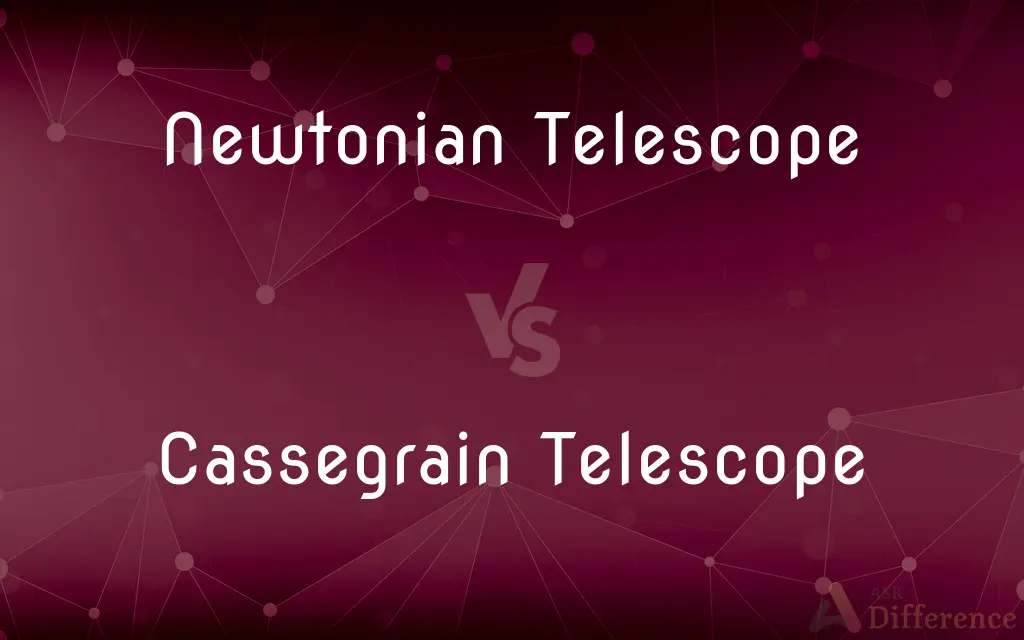Newtonian Telescope vs. Cassegrain Telescope — What's the Difference?
Edited by Tayyaba Rehman — By Fiza Rafique — Published on February 27, 2024
Newtonian telescopes use a parabolic mirror and a flat diagonal secondary mirror for a side focus. Cassegrain telescopes have a primary concave mirror and a secondary convex mirror, focusing light through a hole in the primary for compact design.

Difference Between Newtonian Telescope and Cassegrain Telescope
Table of Contents
ADVERTISEMENT
Key Differences
The Newtonian telescope, designed by Isaac Newton, features a simple two-mirror system with a large parabolic primary mirror at the base to collect light and a small flat diagonal secondary mirror to reflect the light to an eyepiece on the side of the telescope. This design is known for its wide field of view and excellent performance in observing deep-sky objects like nebulae and galaxies, making it popular among amateur astronomers for its ease of use and cost-effectiveness.
Cassegrain telescopes, on the other hand, employ a more complex optical design with a concave primary mirror and a convex secondary mirror that reflects light back through a hole in the primary mirror to an eyepiece at the back. This configuration results in a compact and portable design with a longer effective focal length, making Cassegrain telescopes ideal for detailed observations of planets and lunar surfaces, as well as for astrophotography, due to their high magnification capabilities.
Newtonian telescopes offer a larger aperture at a lower cost, making them great for beginners and those interested in wide-field astrophotography, whereas Cassegrain telescopes, with their closed tube design, are better protected from dust and require less maintenance. The Cassegrain's compact size also makes it more suitable for serious amateur astronomers and researchers who need a telescope that's easy to transport and set up.
The choice between a Newtonian and Cassegrain telescope often comes down to the observer's specific needs: Newtonians are favored for their simplicity and effectiveness in viewing deep-sky objects, while Cassegrains are preferred for their portability and prowess in high-magnification observations.
Comparison Chart
Optical Design
Parabolic primary mirror with a flat secondary mirror
Concave primary mirror with a convex secondary mirror
ADVERTISEMENT
Focal Point
Side of the telescope tube
Through a hole in the primary mirror, at the back of the tube
Field of View
Wide, ideal for deep-sky observation
Narrower, suited for detailed planetary observation
Portability
Generally larger and less portable
Compact and more portable
Cost
Typically less expensive, offering a larger aperture per dollar
Generally more expensive due to complex optics
Maintenance
Open tube design requires more frequent cleaning
Closed tube design limits dust exposure and requires less maintenance
Best Use
Deep-sky viewing, wide-field astrophotography
High-magnification observations, detailed astrophotography
Compare with Definitions
Newtonian Telescope
Ideal for deep-sky observations.
Newtonian telescopes excel in capturing nebulae and star clusters.
Cassegrain Telescope
Compact design with a hole in the primary mirror for focus.
The Cassegrain telescope's design is ideal for portable astrophotography setups.
Newtonian Telescope
Features a side-mounted eyepiece.
The side focus of a Newtonian telescope makes it user-friendly for beginners.
Cassegrain Telescope
Requires less maintenance with its closed tube.
The Cassegrain's design minimizes dust exposure, reducing cleaning frequency.
Newtonian Telescope
Requires regular maintenance due to its open design.
The open tube of a Newtonian telescope needs frequent cleaning to remove dust.
Cassegrain Telescope
Generally more expensive due to complex optics.
The intricate mirrors of a Cassegrain telescope contribute to its higher price.
Newtonian Telescope
Offers a large aperture at a lower cost.
Amateur astronomers often choose Newtonian telescopes for their cost-effective aperture size.
Cassegrain Telescope
Preferred for detailed planetary viewing.
Cassegrain telescopes provide exceptional views of Jupiter's bands and moons.
Newtonian Telescope
Utilizes a parabolic mirror for wide-field viewing.
The Newtonian telescope is perfect for observing the Andromeda Galaxy in full.
Cassegrain Telescope
Suited for high-magnification observations.
Observing lunar craters in detail is a forte of Cassegrain telescopes.
Common Curiosities
Why are Newtonian telescopes popular for astrophotography?
Their wide field of view and large aperture make Newtonian telescopes well-suited for capturing extensive deep-sky objects like nebulae and galaxies.
Is maintenance a big concern for Newtonian telescopes?
The open design of Newtonian telescopes does require more frequent cleaning to maintain optimal performance.
Can Cassegrain telescopes be used for deep-sky observations?
Yes, Cassegrain telescopes can be used for deep-sky observations, but they excel in high-magnification views of smaller objects.
Are Cassegrain telescopes more expensive than Newtonian telescopes?
Generally, yes, due to the more complex optical design and construction of Cassegrain telescopes.
What makes Cassegrain telescopes more portable?
The compact design and shorter tube length of Cassegrain telescopes make them easier to transport and set up.
Can I see planets clearly with a Newtonian telescope?
Yes, while best known for deep-sky viewing, a Newtonian telescope with a suitable focal length and eyepiece can also provide good views of planets.
Why might someone choose a Cassegrain telescope over a Newtonian?
For high-magnification observations, portability, and lower maintenance, a Cassegrain telescope might be preferred.
Is it possible to upgrade a Newtonian telescope to perform like a Cassegrain?
While you cannot change the fundamental design, adding accessories like Barlow lenses can enhance magnification, somewhat mimicking higher magnification capabilities.
Which telescope is better for beginners, Newtonian or Cassegrain?
Newtonian telescopes are often recommended for beginners due to their simplicity, ease of use, and lower cost.
Can the optical design of a telescope affect its image quality?
Yes, the design and quality of the optical system significantly impact the telescope's image clarity, brightness, and contrast.
What are the limitations of Newtonian telescopes?
Their larger size, need for more frequent maintenance, and less suitability for high-magnification planetary observations can be limiting for some users.
How does the eyepiece location affect the use of these telescopes?
The side-mounted eyepiece of Newtonian telescopes is generally considered more comfortable for beginners, whereas the rear eyepiece position of Cassegrain telescopes can be more convenient for astrophotography.
Do all Cassegrain telescopes have a closed tube design?
Most traditional Cassegrain telescopes have a closed tube, but variations like the Schmidt-Cassegrain may have slight differences.
Are there hybrid telescopes that combine features of both Newtonian and Cassegrain designs?
Yes, there are hybrid designs, like the Schmidt-Cassegrain, that incorporate features of both for specific observational advantages.
How do atmospheric conditions affect observations with these telescopes?
Atmospheric conditions, like light pollution and turbulence, can affect observations with any telescope, potentially reducing visibility and clarity of celestial objects.
Share Your Discovery

Previous Comparison
Nutrient Agar vs. Mueller Hinton Agar
Next Comparison
Yellow Pages vs. White PagesAuthor Spotlight
Written by
Fiza RafiqueFiza Rafique is a skilled content writer at AskDifference.com, where she meticulously refines and enhances written pieces. Drawing from her vast editorial expertise, Fiza ensures clarity, accuracy, and precision in every article. Passionate about language, she continually seeks to elevate the quality of content for readers worldwide.
Edited by
Tayyaba RehmanTayyaba Rehman is a distinguished writer, currently serving as a primary contributor to askdifference.com. As a researcher in semantics and etymology, Tayyaba's passion for the complexity of languages and their distinctions has found a perfect home on the platform. Tayyaba delves into the intricacies of language, distinguishing between commonly confused words and phrases, thereby providing clarity for readers worldwide.
















































